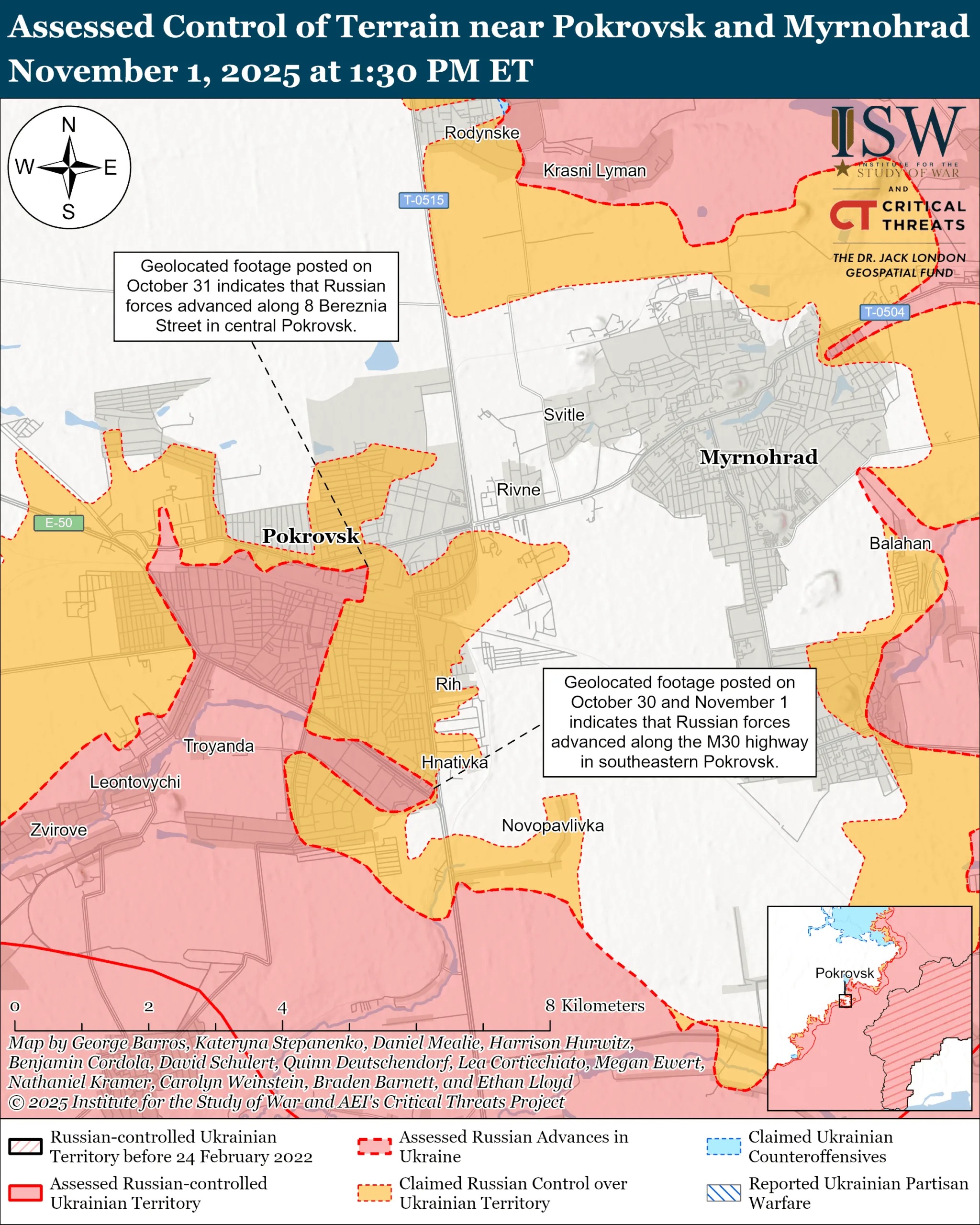ISW: Russia pushes deeper into Pokrovsk as 60% of city turns into frontline maze

Russian forces are intensifying operations around Pokrovsk in Donetsk Oblast, aiming to seize the town as fighting shifts to close-quarters battles under worsening weather, the Institute for the Study of War (ISW) reports. According to the report, geolocated footage confirms recent Russian advances in both central and southeastern Pokrovsk, while Ukrainian troops say Russian units have infiltrated neighboring towns and established near-total fire control over Myrnohrad’s supply route.
Russian troops advance into urban core of Pokrovsk
ISW assessed on 1 November that Russian forces recently pushed deeper into central and southeastern Pokrovsk. Geolocated footage posted on 31 October and 1 November shows Russian troops advancing along Berezina Street in central Pokrovsk and on the M30 highway in the southeastern part of the city. Russian milbloggers went further, claiming advances in areas the footage does not support — including northeastern Pokrovsk and northeast of Kotlyne, southwest of the city.
A senior Ukrainian officer told Ukrainian outlet Hromadske on 31 October that Russian troops are currently operating in about 60% of Pokrovsk and have entered Rodynske to the north and Myrnohrad to the east. Meanwhile, geolocated video confirms Ukrainian forces still hold or recently regained ground in central Rodynske — a location where Russian sources earlier claimed control.

Russian redeployment shifts pressure to Pokrovsk and Myrnohrad
On 1 November, the chief sergeant of a Ukrainian brigade in the Kostyantynivka-Druzhkivka area, northeast of Pokrovsk, reported that Russian forces significantly reduced attacks there following a failed mechanized assault on 27 October. The officer suggested the drop in activity indicates Russia redeployed troops to strengthen its offensive on Pokrovsk and Myrnohrad.
A Ukrainian drone operator working in Pokrovsk told Hromadske that Russian units are isolating some Ukrainian positions through infiltration. A spokesperson for a Ukrainian brigade in the area confirmed logistics have become “complicated” but said Ukrainian ground lines of communication (GLOCs) remain uncut.
A Ukrainian officer said Russian forces have near-total fire control over the narrow road supplying Myrnohrad.
Weather, infiltration, and drone combat reshape the Pokrovsk front
ISW emphasized that fog, rain, and urban terrain are disrupting both Russian and Ukrainian drone operations while shaping infiltration tactics. A Ukrainian officer told Hromadske on 31 October that infantry on the front line rarely engage in direct combat. Instead, Russian forces target drone and mortar crews operating in near rear positions.
The same officer stated that constant Russian infiltrations are forcing Ukrainian drone crews to shorten their flight times and prepare for direct combat, often engaging infiltrators with small arms. Ukrainian units have reportedly been forced to pull back their second echelon drone operators, reducing their capacity to strike Russian forces on Pokrovsk’s outskirts.
One Ukrainian drone pilot said control over high-rise buildings is now decisive. Both sides are fighting for rooftops and elevated terrain that allow operators to hit enemy GLOCs from up to 30 kilometers away.